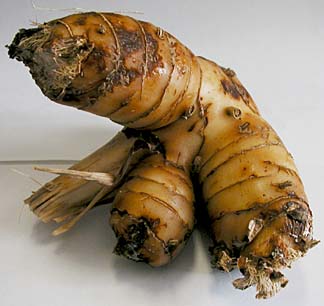

Key Ingredient

|
This member of the Zingiberaceae family is often mistaken for its most famous relation, ginger. Although similar to ginger, galangal has a very unique pungent, peppery flavor which some have compared to camphor.The basics: Galangal, often referred to as Thai ginger, is the rhizome of a tropical plant native to Java and Malaysia. It is used extensively throughout that region. The plant has long blade-like leaves with small, orchid-like flowers. The rhizome is rather gnarly looking and ranges from pinkish orange to beige with a light yellow flesh. It is also covered with intervaled ringed lines.
There are three varieties of galangal: greater galangal (used primarily in Indonesia, Malaysia and India), lesser galangal (used in Indonesia) and Kaempferia galangal (used in Southeast Asia). They possess subtle differences in appearance and taste.
Like ginger, galangal is also valued for its medicinal qualities and has been traditionally used in the treatment of nausea and stomach ailments in addition to having some antibacterial qualities.
Selecting: With fresh galangal, avoid rhizomes that have brown spots or look shriveled. Sliced and bottled galangal, available on a sporadic basis, tends to be less fibrous and easier to grind into pastes for the preparation of sambals and curries.
Storing: Place fresh galangal in the refrigerator for up to a week. Galangal can also be frozen for up to a month.
Use: Galangal is primarily used mashed and ground with other spices for sambals (an Indonesian condiment comprising a number of spices) and curries. It can also be sliced and used to infuse flavor into soups and sauces. Like ginger, galangal is a very popular accompaniment to fish and shellfish.
The rhizome should be rinsed thoroughly before using. Remove any woody parts, but it is not necessary to peel. Galangal is harder to cut into than ginger, so use a sharp cleaver and use the end of the cleaver to pound the slices before using. A mortar and pestle is preferred for grinding galangal, over a food processor.
Where to buy: Fresh galangal, although available year-round, is sometimes difficult to find. Chinatown and the Asian Market on Beretania are good sources. Prices run about $4 to $5 per pound.
Food Stuffs: Morsels
Eleanor Nakama-Mitsunaga is
a free-lance food writer. Contact her
online through features@starbulletin.com